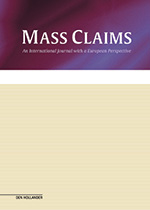Welcome to the Journal of Mass Claims
D.R. Hensler1 Het artikel is in de opmaak van het tijdschrift rechts als pdf beschikbaar.In a world awash with academic journals, practice notes and blog posts, do we really need a new journal devoted to mass claims? Yes! Oddly, as mass claims increase in frequency in countries worldwide – the result of natural catastrophes, man-made disasters, defective products, questionable financial practices and a host of other activities that cause widespread personal injury and financial loss – they have not been the focus of traditional scholarly and professional journals. Although "mass torts" may come to mind when we read the words "mass claims," not all mass claims are founded on tort law, so they do not fit neatly in journals analyzing developments in tort doctrine. Although "collective redress" may come to mind when we read about claimants seeking compensation through the legal system, not all mass claims are resolved within the courts. Often governments and private corporations create special administrative compensation systems to deliver redress to mass claimants. And although traditionally we think of arbitration as a process for resolving one-on-one commercial claims, we are beginning to see attempts to use contract-based arbitration to resolve mass claims. Despite these diverse approaches to resolving mass claims, most scholarship devoted to dispute resolution focuses on courts or on alternative dispute resolution ("ADR") or on arbitration. In sum, "mass claims" are the proverbial "square peg" that does not fit into the traditional pigeonholes of scholarship and practice.
As others have observed, when we organize or think about activities in "silos" such as "tort law" or "collective redress," we miss opportunities to learn. Learning about strategies that help resolve mass claims efficiently and fairly outside of court may help us design and implement dispute resolution procedures when there are private or public policy rationales for bringing claims into courts, and procedures that have proved useful when deployed within courts may offer lessons for private mechanisms. Issues that all dispute resolution systems grapple with can helpfully be analyzed across substantive and procedural law boundaries as well as jurisdictional boundaries. What claims merit redress, by whom? When are collective procedures more efficient and fairer than individualized procedures? What approaches to financing dispute resolution ensure access to justice and redress while restraining the pernicious effects of self-interest? How should the roles of lawyers, judges or arbitrators, mediators and system administrators be balanced? What processes give voice to claimants? These are only some of the questions that are worthy of sustained inquiry.
An increasing number of mass claims have a trans-national dimension. One consequence of this has been renewed attention to private international law doctrine. But resolution of civil claims for the most part remains domestic, meaning that even when a problematic event, product or practice affects people in many countries, different domestic laws, substantive and procedural, come into play. Moreover, long-standing cultural differences may affect how what seems to be the same doctrine or procedural rule on paper, operates "on the ground." While differences in domestic approaches complicate practice, they offer a rich opportunity for comparative analysis that is sometimes overlooked by domestically-oriented practitioners, legal scholars and public policy-makers.
The founders of this journal have learned from formal and informal conferences and meetings that although our experiences with mass claims and the law and cultural understandings that shape their resolution may differ, we have much to learn from each other. By launching this journal, they seek to broaden the conversation and invite you to join in it.


